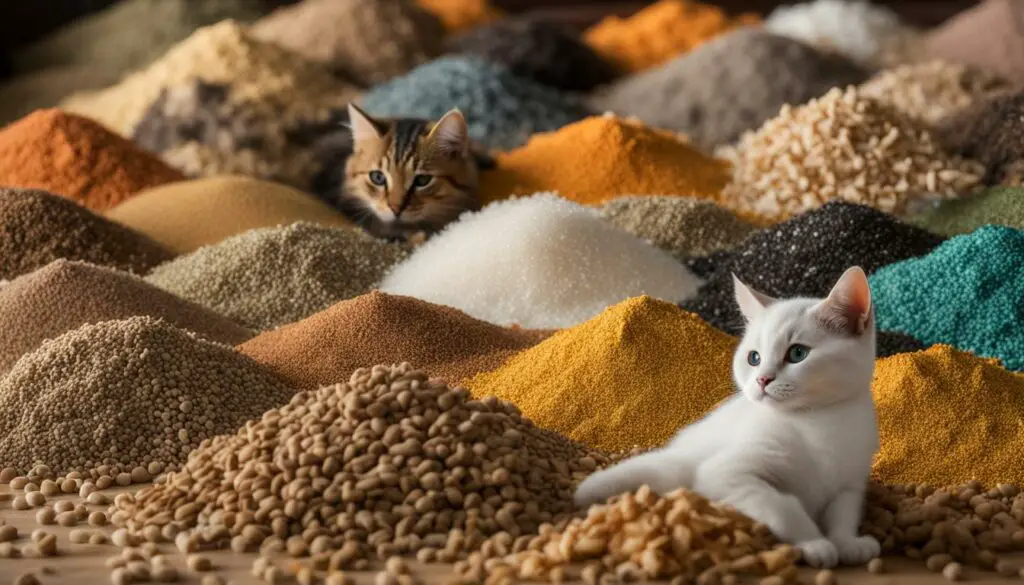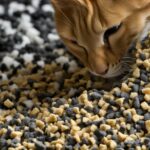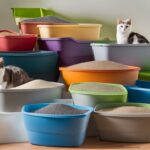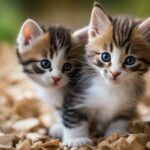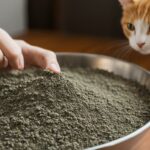When it comes to choosing the right cat litter for your furry friend, it can be overwhelming with the multitude of options available. However, there are some general guidelines to keep in mind. Cats generally prefer smaller litter particles and unscented litters. On the other hand, cat owners often prefer litters that clump well, control odor, have low dust and tracking, and are easy to clean. In this article, we will explore different types of cat litter and discuss their pros and cons to help you make an informed decision.
Key Takeaways:
- Cats prefer smaller litter particles and unscented litters.
- Cat owners prefer litters that clump well, control odor, have low dust and tracking, and are easy to clean.
- There are different types of cat litter available, including clumping clay litters, alternative non-clay litters, and litters for cats with special needs.
- Texture, consistency, clumping vs. non-clumping, and scented vs. unscented are important considerations when choosing cat litter.
- Finding the right cat litter is a personal choice that depends on the individual needs and preferences of both you and your cat.
The Type of Litter Most Cats Prefer
When it comes to cat litter preferences, most cats tend to gravitate towards fine particle litters and unscented options. Cats naturally prefer litter that resembles the texture of sand, which is why they often prefer fine-grained or clumping clay litters. These litters offer a texture that feels comfortable on their paws.
Additionally, cats have a highly sensitive sense of smell, which is why they generally prefer unscented litters. Strong artificial scents can be overwhelming to their delicate noses. By choosing an unscented litter, you are providing a more pleasant and natural environment for your feline friend.
Understanding your cat’s litter preferences is crucial for their overall comfort and well-being. By selecting a litter that meets their preferences for texture and scent, you can ensure that they have a positive litter box experience.
“The texture of the litter is very important to cats, as it can greatly impact their litter box habits and overall satisfaction,” says Dr. Emily Johnson, a veterinarian specializing in feline behavior.
Fine Particle Litters and Cat Preferences
Fine particle litters, such as clumping clay litters, are highly preferred by cats due to their texture. These litters closely resemble the natural feel of sand, which cats are instinctively drawn to. The fine particles are gentle on their paws and provide a comfortable digging experience.
Unscented litters are also favored by cats, as they do not overwhelm their sensitive sense of smell. Cats rely on their sense of smell to navigate the world around them, and strong artificial scents can be overpowering and unpleasant for them. By opting for an unscented litter, you are respecting their natural preference for a scent-free environment.
| Litter Type | Advantages |
|---|---|
| Clumping Clay Litter | – Resembles the texture of sand – Forms tight clumps for easy scooping – Controls odor effectively |
| Unscented Litter | – Does not overwhelm a cat’s sense of smell – Provides a natural and comfortable environment – Allows cats to feel more at ease |
By understanding and accommodating your cat’s litter preferences, you can create a litter box environment that they feel comfortable and happy using. Remember to consider both the texture and scent of the litter, selecting options that closely align with their natural instincts and sensitivities.
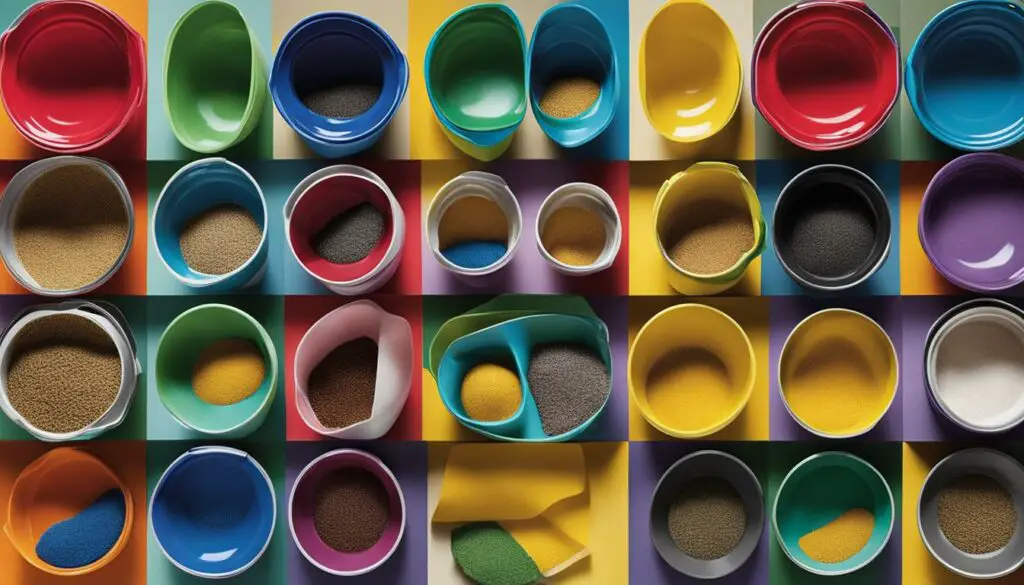
The Type of Litter Most People Prefer
When it comes to choosing cat litter, it’s not just about what your furry friend prefers, but also what qualities you, as a cat owner, value. Most people prefer litters that offer fast and hard clumping, effective odor control, low dust, and low tracking.
Fast and hard clumping litters are highly desirable because they make it easier to clean the litter box. The clumps solidify quickly, preventing the litter from sticking to the box and making it effortless to scoop out. This saves time and ensures a cleaner litter box for both you and your cat.
Another important quality is odor control. Nobody wants their home to be filled with the strong smell of cat urine. Litters that are specifically designed to absorb and neutralize odors are highly preferred. They help keep your home smelling fresh and clean, even with multiple cats.
Low dust and low tracking litters are also popular choices. Dust can irritate your cat’s respiratory system and create a mess around the house. Low-dust litters minimize the amount of dust kicked up when your cat digs in the litter box. Additionally, litters with low tracking properties reduce the amount of litter particles that get scattered outside the box, helping to maintain a cleaner living environment.
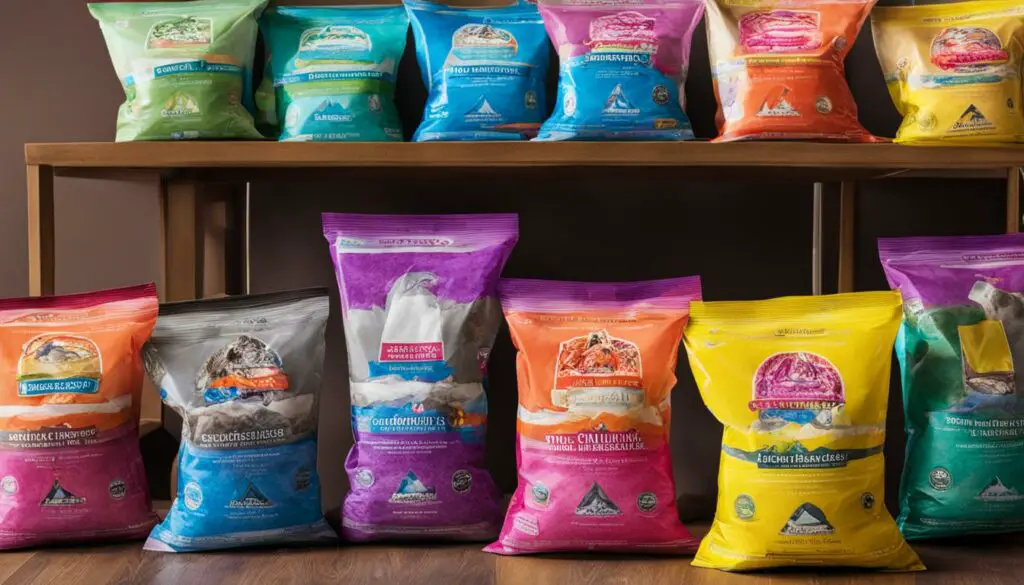
“Fast and hard clumping litters make it easier to clean the litter box.”
Recommended Clumping Clay Litters
When it comes to clumping clay litters, there are a few highly recommended options available in the market. These litters not only offer excellent clumping capabilities but also provide other qualities that both cats and owners appreciate. Let’s take a look at two of these top choices:
| Litter Brand | Key Features |
|---|---|
| Boxiecat All Natural Scent Free Clumping Cat Litter | • Fast and hard clumping • Odor control • Low dust • Low tracking |
| Dr. Elsey’s Low Tracking Unscented Multi-Cat Strength Litter | • Fast and hard clumping • Odor control • Low dust • Low tracking |
Both Boxiecat All Natural Scent Free Clumping Cat Litter and Dr. Elsey’s Low Tracking Unscented Multi-Cat Strength Litter offer the qualities that cat owners look for in a litter. The fast and hard clumping action makes clean-up a breeze, while the excellent odor control keeps your home smelling fresh. These litters also produce minimal dust and are designed to minimize tracking, keeping your floors clean and tidy.
Choosing a clumping clay litter like these options can provide you and your cat with a hassle-free litter box experience. However, it’s important to consider your cat’s preferences and any specific needs they may have before making a final decision.
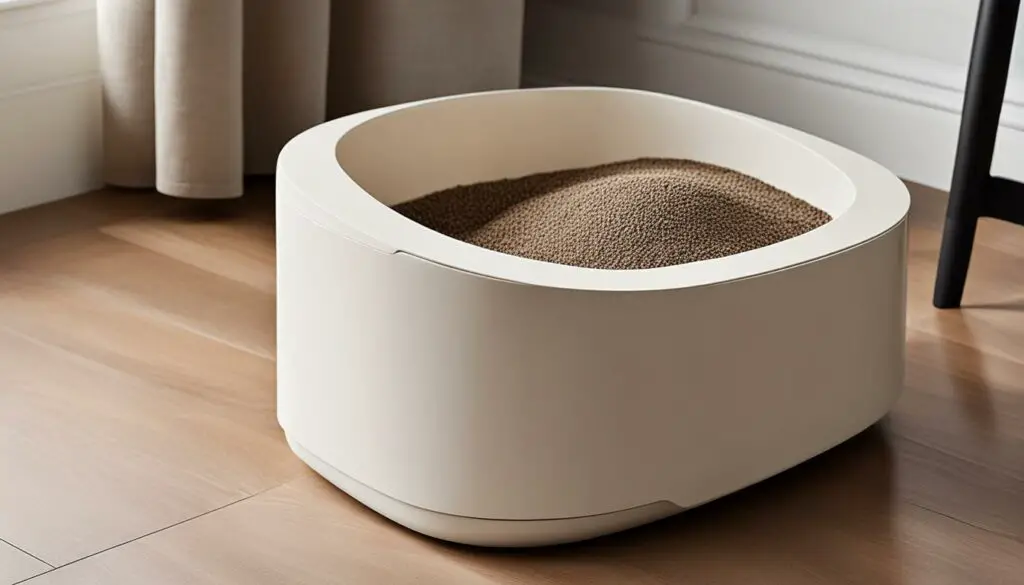
H3: Other Clumping Clay Litters
If none of the recommended clumping clay litters suit your needs, there are other options available in the market. Some of these include:
- Brand A Clumping Clay Litter – Fast and hard clumping, low dust, unscented
- Brand B Clumping Clay Litter – Excellent odor control, low tracking, scented
- Brand C Clumping Clay Litter – Multi-cat strength, low dust, unscented
These litters offer different combinations of qualities, allowing you to choose the one that best fits your cat’s preferences and your own requirements. Remember to consider factors such as clumping ability, odor control, dust production, and tracking when making your decision.
Alternative Non-Clay Litters
For cat owners who prefer non-clay options or have cats that don’t like clay litters, there are alternative options available in the market. These litters are made from natural materials such as corn, wheat, and recycled paper, offering a more eco-friendly choice. They also provide similar qualities to clay litters, including clumping, odor control, and low dust.
One popular alternative non-clay litter is World’s Best All Natural Clumping Cat Litter. Made from corn, this litter forms tight clumps that are easy to scoop, minimizing mess and odor. It is also flushable and septic-safe, making disposal hassle-free. Additionally, this litter is free from added chemicals and perfumes, making it suitable for cats with sensitivities.
Another option is Swheat Scoop All Natural Cat Litter, which is made from wheat and offers excellent odor control. It clumps tightly for easy cleaning and is biodegradable and compostable, making it a more sustainable choice. This litter is also low-dust, making it a healthier option for both cats and their owners.
Alternative Non-Clay Litters Comparison:
| Non-Clay Litter | Main Features | Suitable for |
|---|---|---|
| World’s Best All Natural Clumping Cat Litter | – Made from corn – Forms tight clumps – Flushable and septic-safe – Chemical-free and unscented |
– Cats with sensitivities – Environmentally-conscious owners |
| Swheat Scoop All Natural Cat Litter | – Made from wheat – Excellent odor control – Biodegradable and compostable – Low-dust formula |
– Cats with sensitivities – Environmentally-conscious owners |
When considering alternative non-clay litters, it’s important to keep in mind your cat’s preferences and any specific needs they may have. Some cats may take time to adjust to a new litter, so it’s recommended to gradually introduce the new litter by mixing it with their current litter. By experimenting with different options, you can find the alternative non-clay litter that works best for your cat and provides a more sustainable choice for your home.
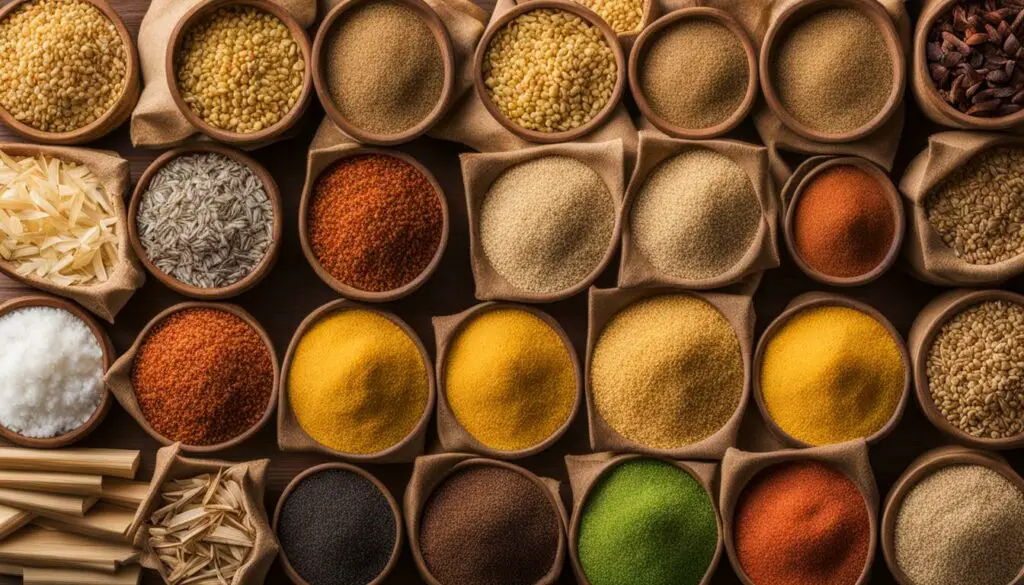
Litters for Cats with Special Needs
When it comes to choosing the right cat litter for your furry friend, it’s important to consider their specific needs. Some cats may require special litters that cater to their unique circumstances. Whether they have asthma, are recovering from surgery, or need help learning to use their litter box, there are litters available that can provide the necessary support.
Litters for Cats with Asthma
Cats with asthma often benefit from low-dust litters that minimize respiratory irritants. Dr. Elsey’s Respiratory Relief Cat Litter is a popular choice in this category, as it is designed to reduce airborne dust and help alleviate breathing difficulties. Another option is Yesterday’s News Unscented Paper Cat Litter, which is made from recycled paper and offers low dust levels for sensitive feline lungs.
Litters for Cats Recovering from Surgery
After surgery, cats require litters that are gentle on their wounds or sutures. Paper-based litters like Yesterday’s News are soft and less likely to stick to surgical sites, reducing the risk of complications. These litters provide a comfortable environment for cats to heal, allowing them to recover more smoothly.
Litters for Cats that Need Help Learning to Use their Litter Box
For cats that are struggling with using their litter box, litters with attractant properties can be helpful. Dr. Elsey’s Cat Litter Attractant is specifically designed to attract cats to their litter box, making it easier for them to understand where to go. By using an attractant, you can encourage your cat to use their litter box consistently, resolving any behavioral issues they may have.
| Litter | Specialty |
|---|---|
| Dr. Elsey’s Respiratory Relief Cat Litter | Low-dust for cats with asthma |
| Yesterday’s News Unscented Paper Cat Litter | Gentle on wounds, ideal for post-surgery recovery |
| Dr. Elsey’s Cat Litter Attractant | Helps cats learn to use their litter box |
By choosing the right litter for your cat’s special needs, you can ensure their comfort and well-being. These specialized litters provide targeted solutions to help cats with asthma, recovering from surgery, or in need of litter box training. Consider their individual requirements and consult with your veterinarian to determine the best choice for your feline companion.
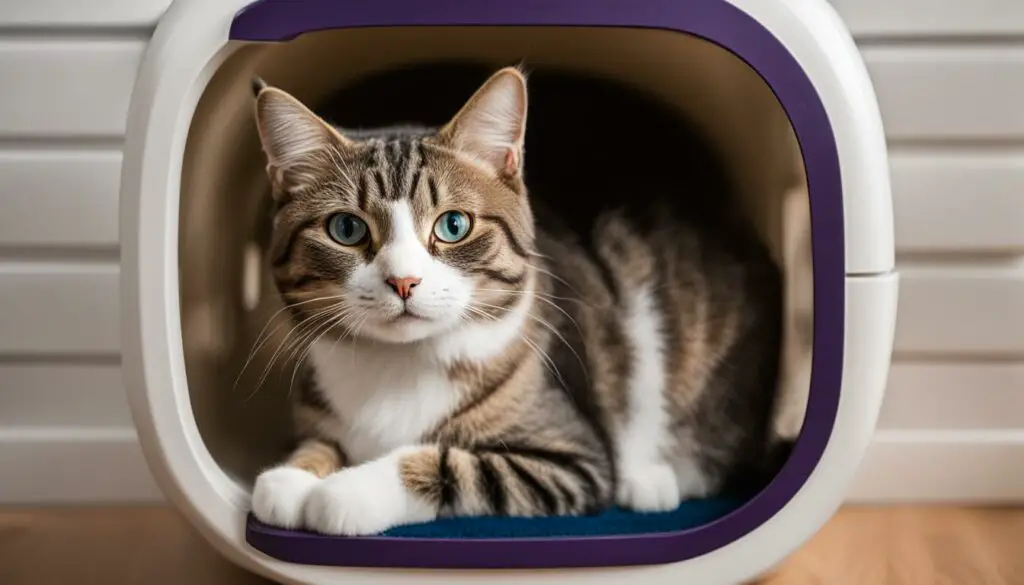
Texture and Consistency Choices
When it comes to cat litter, texture and consistency play a crucial role in both the cat’s comfort and the owner’s satisfaction. There are various options available, including clay litter, crystal litter, and natural materials.
Clay litter is a popular choice due to its ability to control odor effectively. It comes in both clumping and non-clumping varieties, providing convenience and ease of cleaning. However, some cats may not prefer the texture of clay litter, as it can be heavier and less pleasant on their paws.
Crystal litter, made from silica gel, offers superior absorbency and odor control. It has a unique texture that might not be preferred by all cats. While some cats may find it comfortable, others may avoid using the litter box altogether.
“The texture of the litter is an essential consideration. It should provide a comfortable feeling on the cat’s paws, encouraging them to use the litter box.”
For cat owners looking for eco-friendly options, natural materials like recycled paper, pine, and wheat are great alternatives. These litters offer good odor control and are less likely to produce dust. However, it’s important to note that some natural litters may have a different texture compared to traditional clay litters, which may affect a cat’s preference.
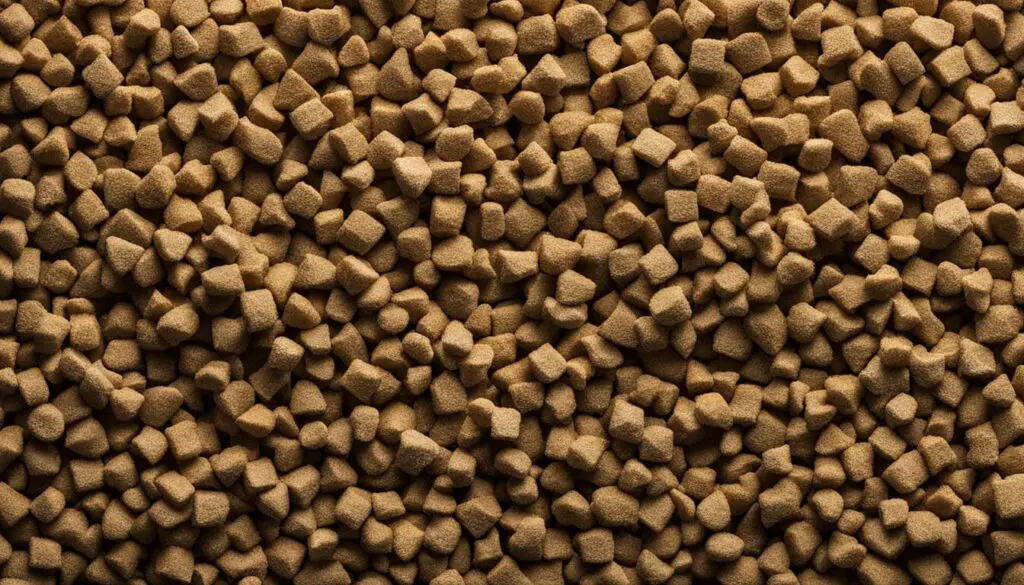
| Litter Type | Texture | Odor Control | Dust Level |
|---|---|---|---|
| Clay Litter | Heavy, granular | Effective | Variable |
| Crystal Litter | Crystalline | Excellent | Low to none |
| Natural Materials | Varies (recycled paper, pine, wheat) | Good | Low to none |
Clumping vs. Non-Clumping Choices
When it comes to choosing the right cat litter, one of the important decisions you’ll need to make is whether to go with clumping or non-clumping litter. Both options have their pros and cons, and the choice ultimately depends on your personal preference and your cat’s specific needs.
Clumping litters are popular for their convenience and ease of use. They form tight clumps when they come into contact with liquid, making it easier to scoop out the waste and keep the litter box clean. Clumping litters also tend to control odor more effectively, as the clumps help to trap and contain odors.
However, it’s worth noting that clumping litters may not be suitable for all cats. Kittens, for example, may be more prone to ingesting litter, and clumping litters can pose a risk if ingested in large quantities. Some cats with sensitive paws may also find the texture of clumps uncomfortable. Non-clumping litters, on the other hand, are generally more affordable and provide good absorbency without the risk of clumping.
If you’re unsure which option is best for your cat, it’s always a good idea to consult with your veterinarian. They can provide guidance based on your cat’s age, health, and any specific concerns you may have. Ultimately, the most important thing is to choose a litter that keeps your cat comfortable, your home odor-free, and makes the litter box cleaning process as hassle-free as possible.
Pros and Cons of Clumping vs. Non-Clumping Litters
| Clumping Litters | Non-Clumping Litters |
|---|---|
| Convenient and easy to clean | More affordable |
| Effective odor control | Good absorbency |
| Risk of ingestion for kittens | No risk of ingestion |
| Possible discomfort for cats with sensitive paws | No clumping, may require more frequent complete replacements |
Remember, it’s important to monitor your cat’s behavior and make adjustments to their litter as needed. Whether you choose clumping or non-clumping litter, regular maintenance and hygiene are essential to ensure your cat’s comfort and well-being.
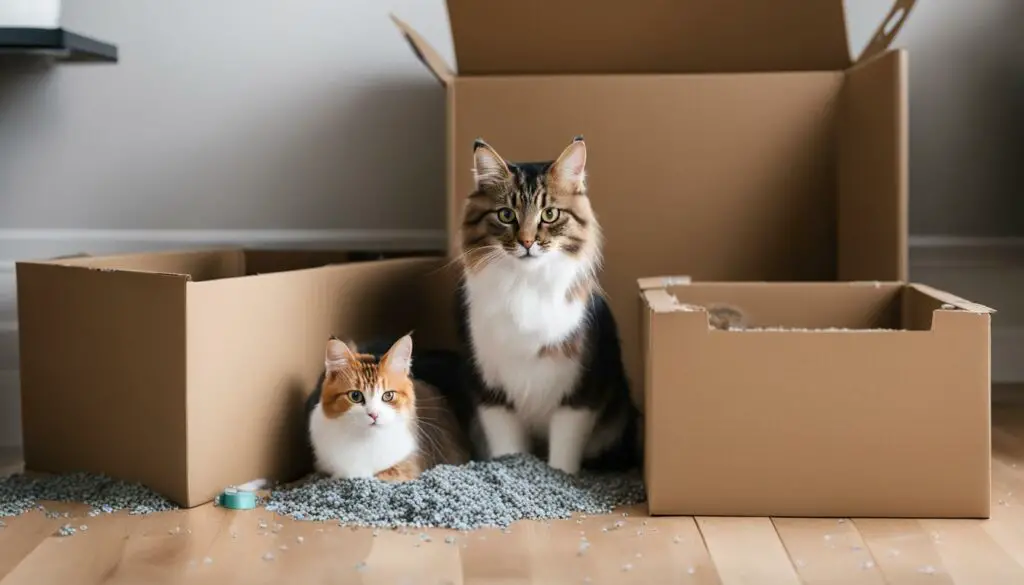
Scented vs. Unscented Choices
When it comes to choosing the right cat litter, one important decision to make is whether to opt for scented or unscented varieties. While scented litters can be enticing to cat owners, it’s essential to consider your cat’s preferences and their sensitive sense of smell. Cats rely heavily on their sense of smell, and strong scents can be overwhelming for them. Therefore, unscented litters are generally preferred by cats and still provide effective odor control when combined with regular scooping and maintenance of the litter box.
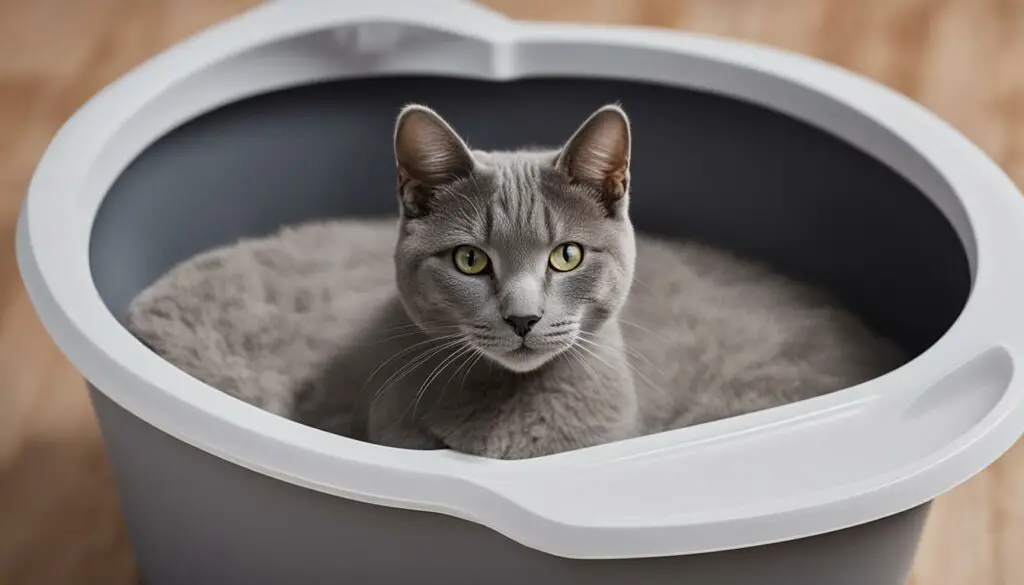
By choosing an unscented litter, you can ensure that your cat is comfortable and content when using their litter box. Unscented litters allow cats to maintain their natural scent without any added fragrances. This can help reduce stress and anxiety, as cats are more likely to feel secure and at ease in their environment.
While unscented litters are recommended for most cats, there may be instances where a scented litter is preferred. Some cat owners find that scented litters help mask odors more effectively, especially in multi-cat households or small spaces. However, it’s crucial to monitor your cat’s response to scented litters, as some cats may develop aversions to strong fragrances or react negatively to artificial additives.
In conclusion, when deciding between scented and unscented litters, it’s important to prioritize your cat’s well-being and consider their preferences. Unscented litters are generally the safer and more cat-friendly option, providing effective odor control without overwhelming your feline companion. Remember to regularly clean and maintain the litter box to ensure a fresh and comfortable environment for your furry friend.
The Evolution of Cat Litter: From Granulated Clay to Clumping Litter
When it comes to cat litter, the options available today are a far cry from the simple sand or ashes that were once used. The history of cat litter is an interesting one, with significant advancements made over the years. The first commercially available cat litter was granulated clay litter, which provided better odor control compared to natural alternatives. However, it wasn’t until the introduction of clumping litter that cat owners truly experienced a revolution in convenience and odor control.
Granulated clay litter paved the way for modern cat litter options. It offered better absorption and odor control than sand or ashes, making it a popular choice among cat owners. However, the real game-changer came with the introduction of clumping litter. Clumping litter is made from a special type of clay that forms solid clumps when it comes into contact with moisture. This allows cat owners to easily scoop out the clumps, leaving behind clean litter and minimizing odor.
“The introduction of clumping litter revolutionized the way we clean our cat’s litter box. It made the process much easier and more convenient, saving us time and effort,” says cat owner Lisa.
Since the introduction of clumping litter, the cat litter market has continued to evolve. Today, there are a variety of options available, including litters made from eco-friendly materials like recycled paper, corn, and pine sawdust. These alternatives offer similar qualities to traditional clay litters, such as clumping and odor control, while also being more environmentally friendly. As cat owners, we now have a wide range of choices to suit our preferences and our cat’s needs.
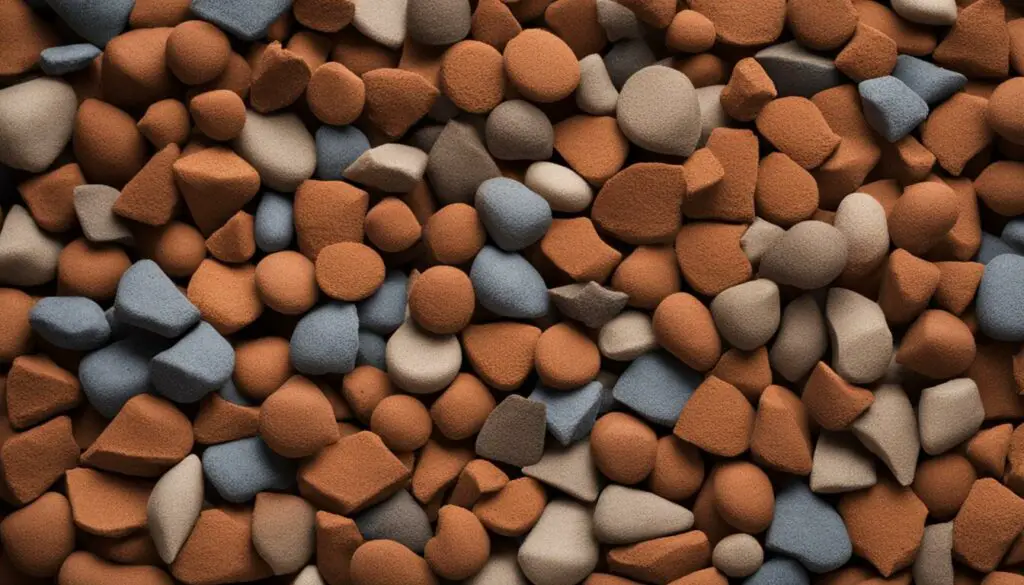
Table: Evolution of Cat Litter
| Period | Litter Type | Key Features |
|---|---|---|
| Pre-20th century | Sand and ashes | Basic absorbency, limited odor control |
| 1940s | Granulated clay litter | Better odor control, improved absorption |
| 1980s | Clumping litter | Easy scooping, convenient odor control |
| Present day | Eco-friendly and alternative litters | Similar qualities to clay litters, better for the environment |
Cat Litter Preferences
In studies conducted on cat litter preferences, fine-grained clumping litter was consistently favored by cats. This type of litter closely resembles the texture of sand, which cats naturally gravitate towards. The fine particles feel comfortable on their paws, providing a sensory experience similar to their natural environment.
Cats have sensitive noses, and they tend to prefer unscented litters. Scented litters may be overwhelming for their delicate sense of smell. Unscented litters effectively control odor when combined with regular scooping and maintenance of the litter box, ensuring a fresh and pleasant environment for both cats and their owners.
While these preferences are generally observed in cats, it’s important to remember that every cat is unique. Some cats may have different preferences based on their individual experiences and personalities. It’s always a good idea to pay attention to your cat’s behavior and preferences when selecting a litter to ensure their comfort and satisfaction.
Why do cats prefer fine-grained clumping litter?
Cats are instinctively drawn to fine-grained clumping litter because it closely resembles the texture of sand, which is the preferred substrate for many feline species. The fine particles provide a pleasant sensation on their paws, mimicking the feeling of digging and covering their waste in soil or sand. This familiarity and comfort make fine-grained clumping litter a popular choice among cats.
Additionally, fine-grained clumping litter tends to form tighter clumps when wet, making it easier for cats to cover their waste and maintain a clean and tidy litter box. The clumping action also helps to control odor, ensuring a fresh and odor-free environment.
| Litter Type | Advantages | Disadvantages |
|---|---|---|
| Fine-Grained Clumping Litter | – Resembles the texture of sand, preferred by most cats – Forms tight clumps for easy cleaning – Controls odor effectively |
– May produce more dust compared to other types of litter – Some cats may have individual preferences |
| Alternative Litters | – Made from eco-friendly materials – Can offer similar clumping and odor control properties |
– Cats may require time to adjust to new textures – Some alternative litters may be less widely available |
| Non-Clumping Litters | – More affordable than clumping litters – Generally more absorbent |
– Requires more frequent complete replacements – Odor control may not be as effective |
Table: Comparison of Different Cat Litter Types
This table provides a comparison of different cat litter types, highlighting their advantages and disadvantages. It’s important to consider these factors when selecting a litter that aligns with both your cat’s preferences and your own preferences as an owner.
Setting Up a Litter Cafeteria
When it comes to determining your cat’s litter preference, setting up a “litter cafeteria” can be a useful technique. This involves providing your cat with different types of litter in separate litter boxes and observing their choices. By doing so, you can gain valuable insights into what type of litter your cat prefers and make an informed decision for their litter box needs.
To set up a litter cafeteria, place a variety of litters in separate boxes side by side. This can include clumping clay litter, non-clumping litter, crystal litter, or litters made from natural materials. Observe your cat’s behavior and note which litter they gravitate towards and use the most. This will give you an indication of their preferences in terms of litter texture, scent, and overall comfort.
Creating a litter cafeteria allows you to see firsthand which litter type your cat prefers. It’s essential to give your cat time to explore and make their choice naturally, without any influence. Take note of their preferred litter and consider factors such as their comfort, litter box usage, and your own preferences when selecting the litter that will suit both you and your cat.
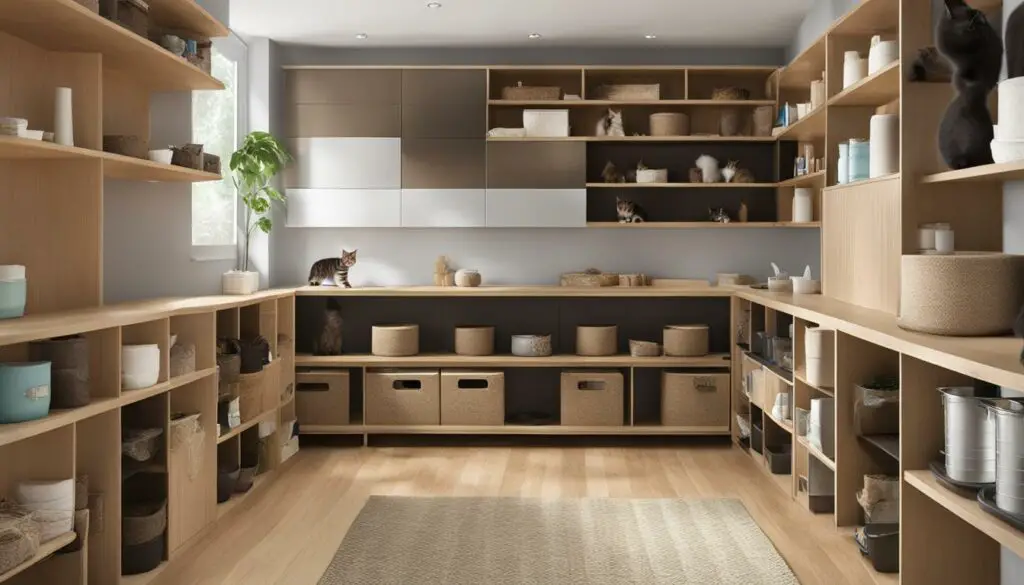
Table: Types of Litter in a Litter Cafeteria
| Type of Litter | Description |
|---|---|
| Clumping Clay Litter | Traditional litter that forms clumps for easy cleaning |
| Non-Clumping Litter | Litter that absorbs liquid but doesn’t clump |
| Crystal Litter | Litter made from silica gel for superior absorbency |
| Natural Material Litter | Litter made from eco-friendly materials like recycled paper or pine |
Considerations to Keep in Mind
When choosing the right cat litter for your furry friend, there are several important factors to consider. These considerations will help ensure that both you and your cat are satisfied with the litter choice. Take into account the texture, absorbency, and ease of use when making your decision.
The texture of the litter is crucial, as it directly affects your cat’s comfort. Cats prefer litters that resemble the texture of sand, such as fine-grained clumping litters. These litters feel softer on their paws and are more appealing to cats.
Absorbency is another vital consideration. Opt for a litter that efficiently absorbs urine and controls odor. Proper absorbency prevents pooling of urine and helps maintain a clean and fresh-smelling litter box. Look for litters that have good absorbency rates to keep your cat’s litter area hygienic.
Lastly, consider the ease of use when selecting cat litter. Choose a litter that is easy to clean and maintain. Some litters clump well, making it easier to scoop and remove waste. Others have low dust and tracking properties, reducing mess and making cleanup less of a hassle. By considering these factors, you can find a cat litter that meets both your cat’s needs and your own.
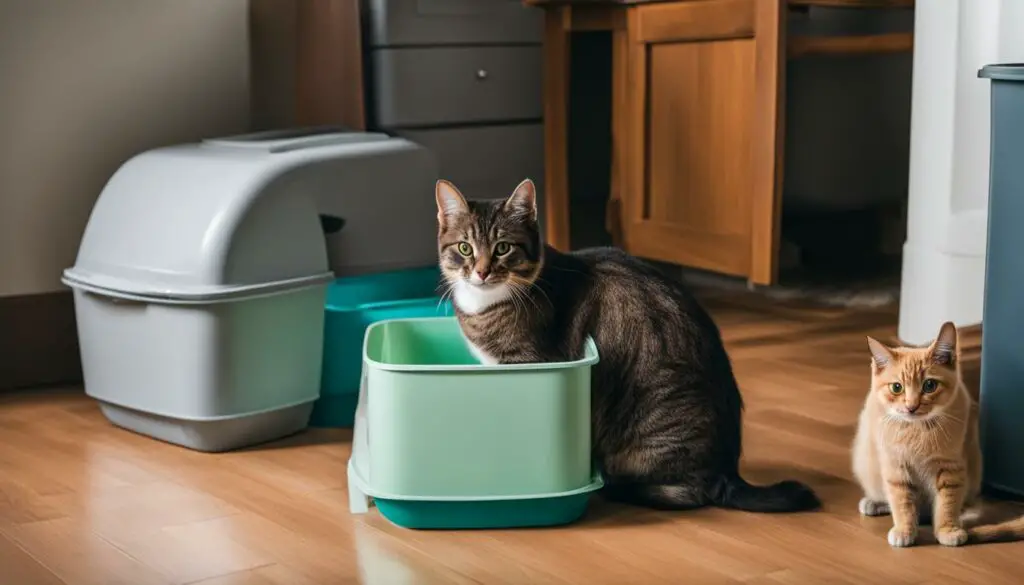
Table: Comparing Cat Litter Considerations
| Consideration | Description |
|---|---|
| Texture | Choose a litter with a texture that resembles sand for optimal cat comfort. |
| Absorbency | Look for a litter with excellent absorbency to control odor and prevent urine pooling. |
| Ease of Use | Select a litter that is easy to clean, with properties such as clumping, low dust, and low tracking. |
Exploring Alternative Cat Litter Options
When it comes to cat litter, there are more options available than ever before. In addition to traditional clay and clumping litters, there are alternative choices that cater to different preferences and needs. These alternative cat litter options often utilize eco-friendly materials, provide unique benefits, and offer convenience for both cats and their owners.
One such alternative is crystal litters. These litters are made from silica gel and offer superior absorbency and odor control. However, it’s important to note that crystal litters may not be suitable for all cats due to their texture. Some cats may not like the feel of the crystals under their paws.
For those looking for eco-friendly options, there are litters made from recycled newspaper, corn cob, and pine sawdust. These litters provide good odor control and are biodegradable, making them a more sustainable choice.
Another convenient option is automated self-cleaning litter boxes. These litter boxes are designed to automatically remove waste, making the cleaning process hassle-free. They often feature sensors that detect when a cat has used the litter box and initiate the cleaning cycle, ensuring a clean and fresh environment for your furry friend.
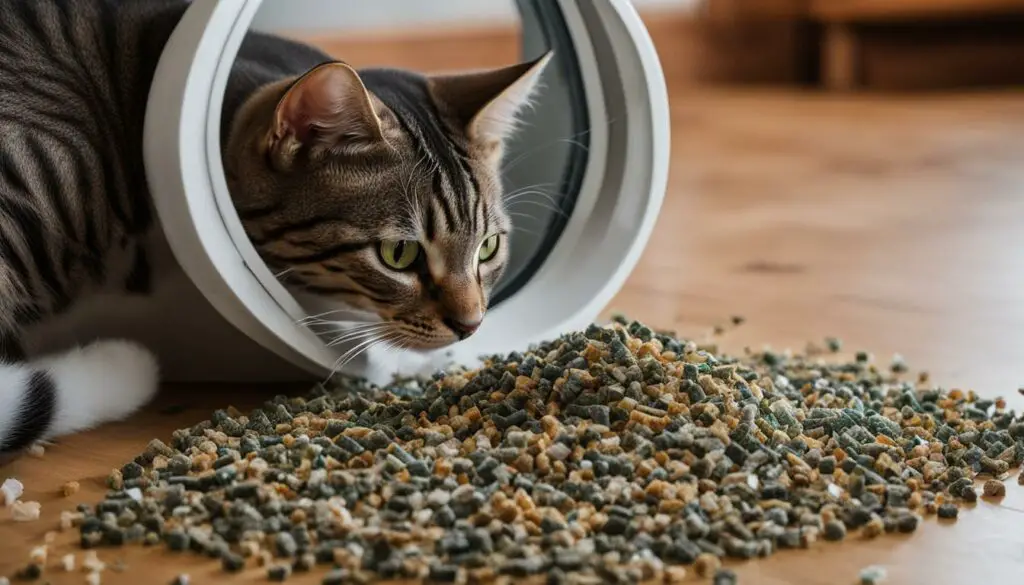
When considering alternative cat litter options, it’s important to take into account your cat’s preferences, any special needs they may have, and the convenience factor for both you and your cat. Experimenting with different types of litter can help you find the best option that meets your cat’s needs and preferences while also providing a clean and comfortable litter box environment.
Conclusion
After exploring various cat litter options, it is clear that choosing the right litter requires considering both your cat’s preferences and your own. While most cats tend to prefer fine-grained, unscented clumping litters, it’s important to remember that every cat is unique.
Take the time to set up a “litter cafeteria” and observe which litter your cat gravitates towards the most. This will provide valuable insight into their preferences and help you make an informed decision.
When making your choice, consider factors such as the texture of the litter, its absorbency, and the ease of cleaning. Remember, personal preference plays a significant role in finding the right litter for you and your cat.
Ultimately, finding the perfect cat litter is a process of trial and error. Stay open-minded and be willing to experiment until you discover the litter that keeps both you and your furry friend happy. With the right litter, you can ensure a clean and comfortable environment for your beloved pet.
FAQ
What type of cat litter do most cats prefer?
Most cats prefer fine particle litters, such as clumping clay litters, that resemble the texture of sand. They also generally prefer unscented litters.
What qualities do most cat owners prefer in a cat litter?
Most cat owners prefer litters that clump well, control odor, have low dust and tracking, and are easy to clean.
Are there any recommended clumping clay litters?
Yes, some recommended clumping clay litters include Boxiecat All Natural Scent Free Clumping Cat Litter and Dr. Elsey’s Low Tracking Unscented Multi-Cat Strength Litter.
Are there alternative non-clay litters available?
Yes, there are alternative non-clay litters available, such as World’s Best All Natural Clumping Cat Litter and Swheat Scoop All Natural Cat Litter.
Are there litters available for cats with special needs?
Yes, there are litters available for cats with special needs. For example, cats with asthma can benefit from low-dust litters like Dr. Elsey’s Respiratory Relief Cat Litter, and cats recovering from surgery may benefit from paper-based litters like Yesterday’s News.
What are some texture and consistency choices for cat litter?
Some texture and consistency choices for cat litter include clay litters, crystal litters, and litters made from natural materials like recycled paper, pine, and wheat.
What are the differences between clumping and non-clumping litters?
Clumping litters make it easier to clean the litter box and control odor, while non-clumping litters are more affordable and absorbent.
Do cats prefer scented or unscented litters?
Cats generally prefer unscented litters, as scented litters may be overwhelming to their sensitive sense of smell.
What is the history of cat litter?
The first commercially available cat litter was granulated clay litter, followed by clumping litter. Over time, new types of litters made from eco-friendly materials have emerged.
How can I determine my cat’s litter preference?
You can set up a “litter cafeteria” with different types of litter in separate litter boxes and observe which litter your cat chooses to use the most.
What factors should I consider when selecting cat litter?
Factors to consider when selecting cat litter include texture, absorbency, and ease of use.
Are there alternative cat litter options available?
Yes, there are alternative cat litter options available, including litters made from eco-friendly materials and automated self-cleaning litter boxes.
How do I find the right cat litter?
Finding the right cat litter is a personal choice that depends on the individual needs and preferences of both you and your cat. Experimentation and observation may be necessary to find the litter that works best.

